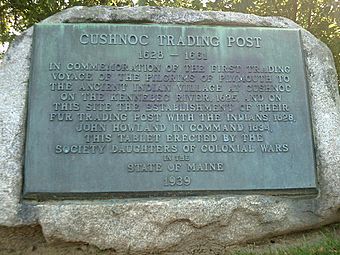Cushnoc Archeological Site facts for kids
|
Cushnoc (Cushnoc Archeological Site)
|
|
 |
|
| Nearest city | Augusta, Maine |
|---|---|
| Built | 1628 |
| NRHP reference No. | 89001703 |
Quick facts for kids Significant dates |
|
| Added to NRHP | October 27, 1989 |
| Designated NHL | April 12, 1993 |
The Cushnoc Archeological Site is a special place in Augusta, Maine, where people have found amazing clues about the past. It was once a busy trading post built in 1628 by English colonists from Plymouth Colony. This trading post was on the Kennebec River and was super important for trading furs with the local Native American people.
Today, Cushnoc is next to Fort Western, which is another old fort built much later. The site is important because it helps us understand how people lived, traded, and built things in the early days of colonial settlement in New England. Because of its historical importance, it was named a National Historic Landmark in 1993.
Contents
What Was Cushnoc?
Cushnoc was a trading post built by English colonists from Plymouth Colony. Plymouth Colony was started in 1620 by people who came from England, looking for a new life. To make money and pay back the people who helped them come to America, the colonists started trading with the Native American people who already lived there. They mainly traded for furs.
Why Was Cushnoc Built?
In 1628, the Plymouth colonists set up this trading post on the Kennebec River. They called the area "Cushnoc." This spot was perfect for trading because the river was a major travel route. The colonists were not the only ones trading on this river, but their post at Cushnoc was very important. The Plymouth colonists stopped trading on the Kennebec River around 1661.
Later, in 1754, Fort Western was built very close to where the old trading post had been. People at the time knew that the Plymouth Colony had a "Garrison" (a military post or fort) in that same spot about a hundred years earlier.
Discovering the Past at Cushnoc
The Cushnoc site was found and carefully dug up by archaeologists between 1984 and 1987. It is located on the east side of the Kennebec River, just south of Fort Western. Part of the land where the site is located is owned by a local church.
What Did Archaeologists Find?
During the dig, archaeologists were able to find the outlines of the trading post's strong wooden wall, called a palisade. They also found holes in the ground where wooden posts for buildings had once stood. These buildings were "earthfast," meaning their main support posts were set directly into the ground.
All these discoveries, along with other items, were found beneath the top layer of soil that had been disturbed by farming over the years. The soil underneath was sandy, which helped preserve the old remains.
Clues from Artifacts
The objects found at Cushnoc were similar to things found at other sites from the mid-17th century. These artifacts included:
- Tobacco pipes
- Glass beads
- Everyday pottery (ceramics)
- Pottery from France and Spain
- Many hand-forged nails
These findings help us learn a lot about the relationships between the English traders, the Native American people, and even the nearby French settlements in Acadia. More digging and research are expected to reveal even more about this fascinating time in history.
The Cushnoc site was officially recognized and added to the National Register of Historic Places in 1989. Then, in 1993, it was given the even higher honor of being named a National Historic Landmark.



